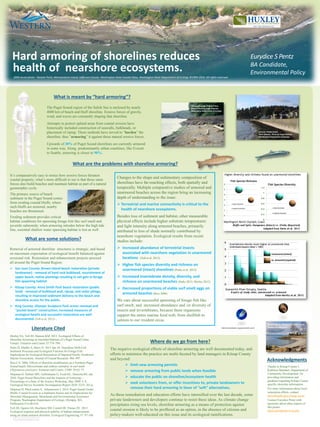Weitere ähnliche Inhalte
Ähnlich wie ShoreArmorEPentz
Ähnlich wie ShoreArmorEPentz (19)
ShoreArmorEPentz
- 1. RESEARCH POSTER PRESENTATION DESIGN © 2015
www.PosterPresentations.com
The Puget Sound region of the Salish Sea is enclosed by nearly
4000 km of beach and bluff shoreline. Erosive forces of gravity,
wind, and waves are constantly shaping that shoreline.
Attempts to protect upland areas from coastal erosion have
historically included construction of seawalls, bulkheads, or
placement of riprap. These methods have served to “harden” the
shoreline, thus “armoring” it against those natural erosive forces.
Upwards of 30% of Puget Sound shorelines are currently armored
in some way. Along predominantly urban coastlines, like Everett
to Seattle, armoring is closer to 90%.
What is meant by “hard armoring”?
What are the problems with shoreline armoring?
What are some solutions?
Removal of armored shoreline structures is strategic, and based
on maximum expectation of ecological benefit balanced against
erosional risk. Restoration and enhancement projects proceed
all around the Puget Sound Region:
San Juan County: Brown Island beach restoration (private
landowner) - removal of hard rock bulkhead, nourishment of
upper beach, native plantings resulting in net gain in forage
fish spawning habitat
Kitsap County: Anna Smith Park beach restoration (public
land) - removal of bulkhead wall, riprap, and cedar pilings,
resulting in improved sediment delivery to the beach and
shoreline access for the public.
King County: Olympic Sculpture Park armor removal and
“pocket beach” construction; increased measures of
ecological health and successful restoration are well
documented (Toft et al. 2013) .
Literature Cited
Thanks to Kitsap County’s
Kathlene Barnhart, Department of
Community Development, for
providing information and
guidance regarding Kitsap County
specific shoreline information.
For more information about local
restoration efforts, contact
shorefriendly@co.kitsap.wa.us.
Contact Eurydice Pentz with
questions about other aspects of
this poster:
pentze@students.wwu.edu
Where do we go from here?
The negative ecological effects of shoreline armoring are well documented today, and
efforts to minimize the practice are multi-faceted by land managers in Kitsap County
and beyond:
limit new armoring permits
remove armoring from public lands when feasible
educate the public on shoreline/ecosystem health
seek volunteers from, or offer incentives to, private landowners to
remove their hard armoring in favor of “soft” alternatives.
As these remediation and education efforts have intensified over the last decade, some
private landowners and developers continue to resist these ideas. As climate change
precipitates rising sea levels, shoreline armoring as a means of protection against
coastal erosion is likely to be proffered as an option, in the absence of citizens and
policy-makers well-educated on this issue and its ecological ramifications.
Eurydice S Pentz
health of nearshore ecosystems.
Acknowledgments
Morley SA, Toft JD, Hanson KM. 2012. Ecological Effects of
Shoreline Armoring on Intertidal Habitats of a Puget Sound Urban
Estuary. Estuaries and Coasts 35:774–784.
Parks D, Shaffer A, Barry D. 2013 Apr 10. Nearshore Drift-Cell
Sediment Processes and Ecological Function for Forage Fish:
Implications for Ecological Restoration of Impaired Pacific Northwest
Marine Ecosystems. Journal of Coastal Research: 984–997.
Rice CA. 2006. Effects of shoreline modification on a Northern Puget
Sound beach: Microclimate and embryo mortality in surf smelt
(Hypomesus pretiosus). Estuaries and Coasts: J ERF 29:63–71.
Shipman H, Dethier MN, Gelfenbaum G, Fresh KL, Dinicola RS, eds.
2010. Puget Sound Shorelines and the Impacts of Armoring—
Proceedings of a State of the Science Workshop, May 2009: U.S.
Geological Survey Scientific Investigations Report 2010–5254, 262 p.
Shipman H, MacLennan A, Johannessen J. 2014. Puget Sound Feeder
Bluffs: Coastal Erosion as a Sediment Source and its Implications for
Shoreline Management. Shorelands and Environmental Assistance
Program, Washington Department of Ecology, Olympia, WA.
Publication #14-06-016.
Toft JD, Ogston AS, Heerhartz SM, Cordell JR, Flemer EE. 2013.
Ecological response and physical stability of habitat enhancements
along an urban armored shoreline. Ecological Engineering 57: 97-108.
Changes to the shape and sedimentary composition of
shorelines have far-reaching effects, both spatially and
temporally. Multiple comparative studies of armored and
unarmored beaches across the region bring an increasing
depth of understanding to the issue:
Terrestrial and marine connectivity is critical to the
health of nearshore ecosystems.
Besides loss of sediment and habitat, other measurable
physical effects include higher substrate temperatures
and light intensity along armored beaches, primarily
attributed to loss of shade normally contributed by
nearshore vegetation. Ecological results from recent
studies include:
Increased abundance of terrestrial insects
associated with nearshore vegetation in unarmored
locations (Toft et al. 2013)
Higher fish species diversity and richness on
unarmored (intact) shorelines (Parks et al. 2013)
Increased invertebrate density, diversity, and
richness on unarmored beaches (Parks 2013; Morley 2012)
Decreased proportions of viable surf smelt eggs on
armored beaches (Rice 2006)
We care about successful spawning of forage fish like
surf smelt, and increased abundance and /or diversity of
insects and invertebrates, because these organisms
support the entire marine food web, from shellfish to
salmon to our resident orcas.
It’s comparatively easy to notice how erosive forces threaten
coastal property; what’s more difficult to see is that those same
forces also build beaches and maintain habitat as part of a natural
geomorphic cycle.
The primary source of beach
sediment in the Puget Sound comes
from eroding coastal bluffs; where
such bluffs are armored, nearby
beaches are threatened.
Eroding sediment provides critical
habitat conditions for spawning forage fish like surf smelt and
juvenile salmonids; when armoring intrudes below the high tide
line, essential shallow water spawning habitat is lost as well.
BA Candidate,
Environmental Policy
Hard armoring of shorelines reduces
2006 aerial photo - Nodule Point, Marrowstone Island, Jefferson County: Washington State Coastal Atlas, Washington State Department of Ecology ©1994-2016 All rights reserved.
Puget Sound Feeder Bluffs (Shipman et al. 2014)
Riprap armoring, Seahurst Park,
Burien. Photo by Hugh Shipman
Washington Department of Ecology
Seawall, Maple Beach,
Point Roberts . Photo by Hugh Shipman
Washington Department of Ecology.
Pocket Beach, Olympic Sculpture Park
Seattle Art MuseumMarine invertebrates: copepod, benthic worm
